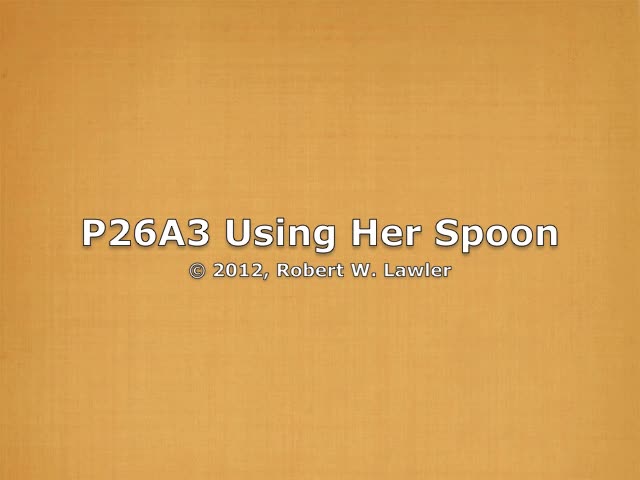
P26A3 Clip Notes
| Notes:n:nn | by Analyst, 10/21/2024 |
| Setting,Props | Cedar Hall, Family Room: |
| Actors,Aims | Peggy and Mom; Bob on camera. |
| Episode A: | Bob: Let’s see what she wants to do with that spoon. Mom: Losing under my knee? She wants to do the same old thing, pick it up and put it in her mouth. Is that right? Bob: Where was that dropped? Was it still within her sight? Mom: Yes, she dropped it on my foot… |
| Episode B: | Peggy: [Peggy’s extended handling and mouthing the spoon] Mom: Did it taste good? Peggy: [places spoon in contact with foot, then rubs her other foot, finally leaning down to mouth the spoon in contact with her foot] Mom: Ooo. Way over! Peggy: [sitting up, she moves fist and spoon behind her head; bringing it back, she hurts herself] Bob: She jabbed herself? Mom: She jabbed herself from the small. {P: starts to cry} |
| Episode C: | Bob: Well, why don’t you give her the wash cloth to play with then? My goodness, we don’t want her to hurt herself. Mom: Come on [removing spoon]. Here, remember this? (wash cloth, received with little enthusiasm) Or isn’t it so much fun if it’s not soggy? Peggy: [pushes aside the cloth and turns to the mirror] Bob: What’s the matter, Peg? Oh, you want to play with that other baby again, huh? Oh, my… Peggy: [returned to Mom’s lap, she retrieves and mouths the cloth, turns to Bob and says “ehn”] Bob: Hi, Peggy. |
| Episode D: | Bob: I guess she’s not going to play Peekaboo all on her own this time. {Mom: No, I guess not} just making faces as that other baby in the mirror again. Let’s stop here for a while. | Episode |
| Summary by AI |
The scene starts with observing what Peggy wants to do with a spoon. She drops the spoon (onto the speaker’s foot) and then picks it up to mouth it. The adults check whether the drop was within her sight; it was. Peggy explores by placing the spoon against her foot, rubbing, and then leaning down to mouth it in contact with her foot. She moves the spoon behind her head and accidentally jabs herself, leading to crying. Concerned, the adult removes the spoon and offers a washcloth instead to prevent injury. Peggy shows little enthusiasm for the dry washcloth, seeming to prefer it soggy. She pushes the cloth aside and turns attention to the mirror, interested in the “other baby.” Returned to a lap, she mouths the cloth again, vocalizes “ehn” toward Bob, and doesn’t start Peekaboo on her own. The segment concludes with noting she’s just making faces at the mirror and deciding to stop for a while. |
| Narrative by AI |
A brief observational moment captures a baby named Peggy exploring a simple object: a spoon. She reaches for it, drops it, and recovers it, alternating between grasping, mouthing, and relocating it around her body. The adults nearby comment on her actions, noting where the spoon falls and whether she can still see it after it drops. Their running commentary frames the scene as an everyday episode of curiosity and coordination, with attention to how she engages her senses and manages an object in space. Peggy experiments with touch and taste, bringing the spoon to her mouth and even pressing it against her foot before leaning down to mouth it in contact with her skin. These actions suggest a sensory-driven exploration: she appears to test the object’s texture, temperature, and position. The spoon becomes more than a utensil; it serves as a tool for learning about cause and effect and the relationship between her body and the environment. The adults observe without directing too much, allowing her to lead the interaction. At one point, Peggy moves the spoon behind her head and then brings it back, accidentally jabbing herself. The mishap leads to brief distress, and the adults step in to remove the spoon and offer a safer alternative—a washcloth. The switch reflects a common balance in caregiving: encouraging exploration while adjusting the environment to prevent injury. The washcloth, less novel when dry, doesn’t hold the same appeal, and Peggy redirects her attention. Her focus turns to a mirror, where she appears interested in the “other baby.” The adults note that she is not initiating peekaboo this time but is still drawn to the reflection. This quiet engagement is typical of early social and visual exploration. The mirror offers immediate feedback and motion that can be compelling even without explicit games, and Peggy’s attention suggests an ongoing curiosity about faces and movement. The sequence concludes with Peggy back on a caregiver’s lap, mouthing the washcloth and briefly vocalizing. The adults decide to pause the session. Overall, the scene provides a snapshot of everyday development: object handling, sensory exploration, early problem-solving, and caregiver support. Nothing dramatic happens, yet these small moments collectively map how infants learn—through repetition, safe boundaries, and the freedom to discover. |
| Link Index | Panel P026, Language Development, Object Exploration, Social Interactions |
| Themes, Interplay |
